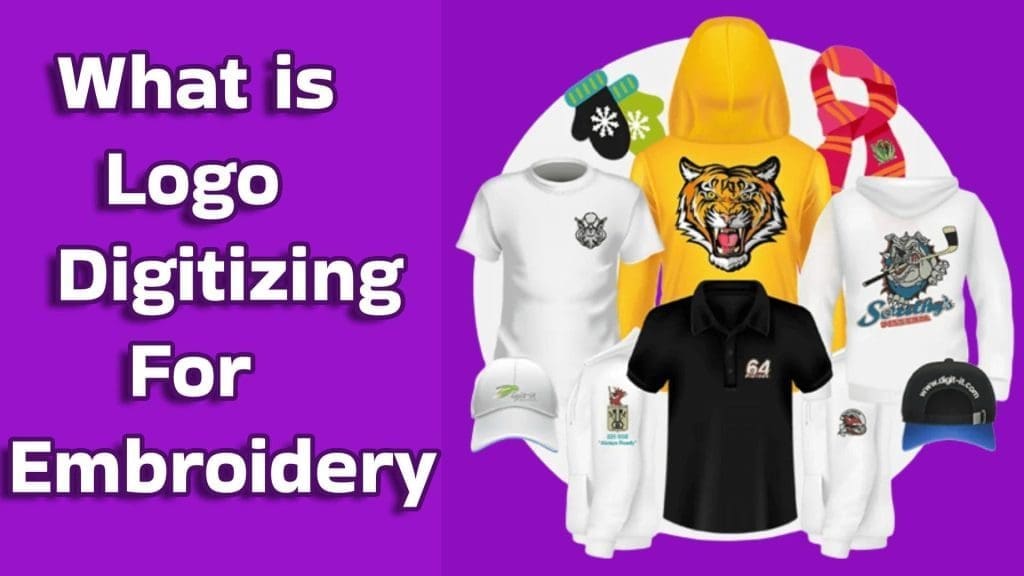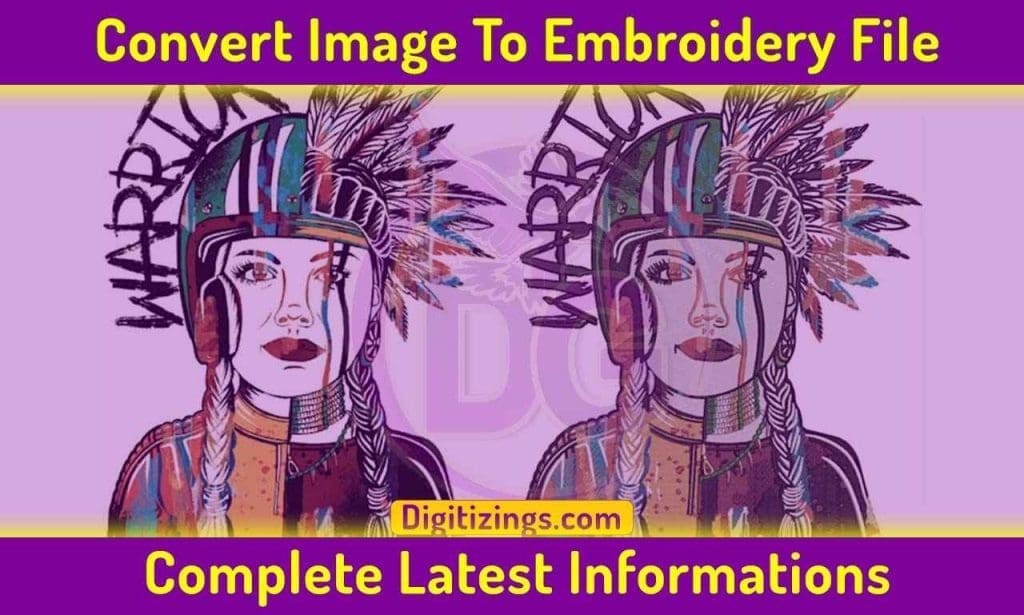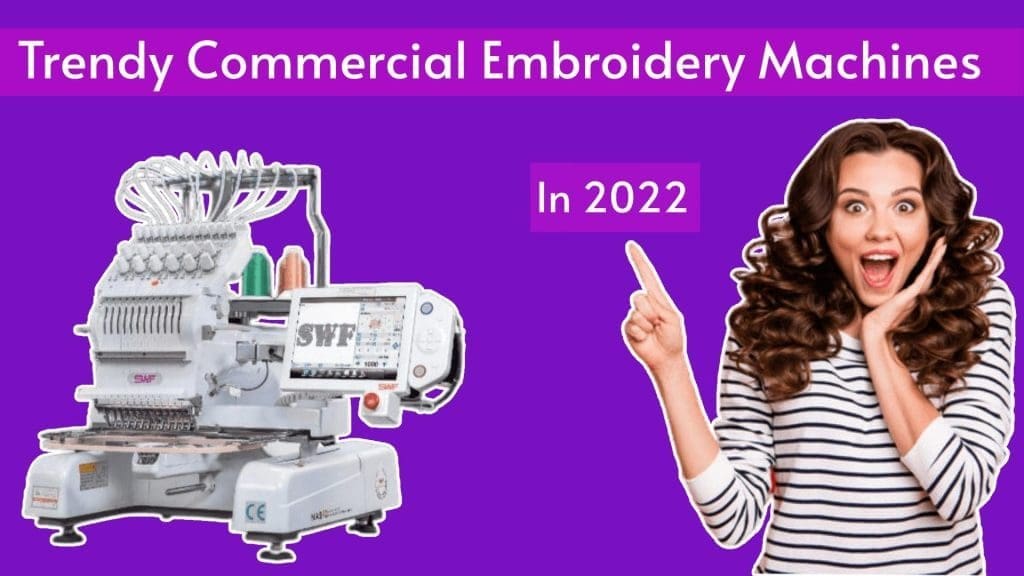What is logo digitizing for embroidery? Logo Digitizing Detailed Overview

How to digitize logo for embroidery or 3d logo digitizing, also embroidery digitizing logo for embroidery machines?
Everyone wants to be noticed. If we are wearing an polo or a school uniform, it’s got an image on it. This is the place where embroidery digitized logos can be useful. In this post we will discuss the digitizing of embroidery logos process. What it is and the process of doing it. It sounds simple, doesn’t it? Let’s look at it!
What is Logo Digitizing for Embroidery? Or What Embroidery Digitized logo Process Step by Step
Before we begin what goes into digitizing an embroidery logo and embroidery, we have to know what an image is. In the simplest terms the definition of a logo is symbol that used to symbolize an individual brand or business. The logo is the symbol that defines the standing of a firm or business.
Like our names, logos are the identifier that makes our business and company unique.
Digitizing An Embroidery Logo Online
We will now explain each step you should be looking for when trying to create a logo. When digitizing embroidery, machines cannot recognize general file formats. So, we must digitize our logo or design in a file format that machines can recognize.
To provide an example to illustrate, the jpeg and png formats are among the most popular file formats used on computers. However, the same formats do not work with embroidery machines. embroidering machine. It is necessary to digitize them to allow embroidery.
Most Common Online Embroidery Logo Digitizer Formats Available
These are a few of the most popular emblem embroidery styles that you may see:
- (*.dst) – Tajima
- (*.pes) – Deco, Brother, Babylock
- (*.jef) – Janome, Elna, Kenmore
- (*.emb) – Wilcom
- (*.exp) – Melco
- (*.hus) – Husqvarna Viking
- (*.art) – Artista Design
The options are endless. There are a variety of formats on the market to digitize embroidery logos. However, this won’t be enough for a beginner or even a professional digitizer to finish the job.
In today’s world of digitalization there are a variety of ways to accomplish a task. It’s all about the skills and knowledge. One of the most difficult of all processes is digitizing embroidery Logos or Letters that sew perfect on your machine.
embroidery for letters is popular and a sought-after product for the digitizing business. This process comes with its own demands. This is due to the handwritten letters differ from the machine digitizing of letters.
This article we’ll discuss all methods of digitizing letters. To inform you in the most effective way we will guide you through the entire process from beginning to the very end.
Embroidery Letters Technique
The art of embroidery is creating patterns and designs on fabric. letter digitizing is an embroidery method that is more complicated than other embroidery services. Let’s look at the procedure!
Before you design a new one, there are certain aspects must be taken into consideration in order to avoid any issues. How you create your design will form the foundation of your final product. If you’re making the embroidery of letters the initial step is to ensure that you get the same outcome on both machines and software. If you’re a novice you have fewer opportunities to achieve the same result.
To do this, we need to play with the stitching and size of the design. In certain places you’ll need reduce the size, while in others it is the reverse. However, it’s not as easy as it might seem. The stitching out of fabric is a common issue for beginners. Even experts need to pay the right care when creating the stitches to avoid any annoyance.
Draw A Pull Push Line
Usually when it comes to embroidery, the machine makes two extra stitches at the beginning and at the end. To do this, we need to draw an outline on the upper part of the word. Make use of to use the (input C) tool. Left-click the tool and assign the value of 0.01 inch. The line is referred to as “Pull Push Line”.
Merging The Lines
When we’ve completed the pull-push line on the top of our letter, we need to join the lines. Choose the merge option in the upper-right corner. Then (press G) The line you select will merge with the lower line. The two lines will join in one continuous line. When pressing G, we can shift or move the line. But, we aren’t able to modify the line.
Aligning The Line
After merging the line we need to align it just as we would in other editing programs. It is necessary to draw the line at the bottom and top in a manner that it creates an exact alignment.
Making A Straight Point
We now need to draw a straight line. In order to do that, we need use this (Input The A) tool. Left-click the tool , and press the control button well to get the message across. By pressing the control key, you will create a precise line to embroidery letters or shapes. stitched alphabet or the shape.
Press on the D button. This will block any background images.
Closest Point Lettering
It is a different element that defines what is the level of quality that digitizers provide and is the most crucial element to observe throughout the digitizing of embroidery. The point at which you begin the next segment is closer to the finish point of the first segment to prevent any extra stitches being that are taken in the process. This will result in more thread use and consume additional time, if don’t adhere to exactly the closest point in the lettering process. The smaller the trim the better it is the digitizing quality.
Then you press on the button H. It will display all edges beginning, angles, and end points. The only thing you have to do is place the end point of the first object next to the beginning point of the second object. This will allow the machine to create an ideal cut.
Then press then the L button. It will display the view as well as the grid. It can help you see the shapes’ alignments. If you would like to see the stitch, click the button T. One thing you’ll have to think about concerns the aligning and positioning that the stitch is placed. Because sometimes, the machine produces stitches that are outside of the alignment, making the appear blurred.
It is likely that the letter A would fall underneath the letter B as we first made it. In the same way, we must make sure that the alphabets C and B in close proximity so that there’s no empty space left. This is because if the fabric stretches in this way, it will not show any empty space.
Then, press on the button T. It will display the final view , known as the “True View”. Your letter is now ready for your next stage.
The Process of Logo Embroidery Digitizing
There are a variety of methods to perform the digitization of logos in embroidery. However, the basic principles of the process of digitized logo is the exact same. If we split the work into segments, you can design logos using the following list.
- Editing and uploading the image
- The stitch type, as well as the direction
- The thread colour is picked up
- Smoothing out the outline
- If necessary, make additional adjustments
- The right needle for embroidery
Uploading And Editing The Image
The initial step is the same the way you’d make any design. Upload the image or file to the program. The files could be in any format , such as PNG, JPEG or another. We must get rid of the blank spaces.
Set up your preferred embroidery size for your logo or pattern. Make sure you make sure to lock the image prior to making any other changes.
Setting The Stitch Type And Direction
When you’re done with the image resizingprocess, you need to select the correct type of stitch to make your brand. The type of stitch depends on the fabric on which you intend to stitch. Based on the material, fabric, as well as the design the stitch’s type may differ.
What Exactly Is An Embroidery Stitch?
Within the realm of digitizing embroidery the term “stitch” is basically the movement of the needle forward and back to the fabric, with the aid of thread. The thread stroke that is made on the front of the needle is known as a’stitch’..
Like the smaller unit of the computer is. A stitch is the tiny unit. We create patterns using multiple stitches , which form an image. This is the stitch that creates the image or logo.
In this article, we will speak about the 5 most fundamental stitches for embroidery.
-
The Running Stitch
In a running stitch we need to make holes into the fabric to allow the stitches to be run. It appears smooth when moving. Running stitch appears smooth when it is in motion. considered to be one among the most fundamental stitches in embroidery. Have you ever seen your grandmother or aunt stitching stitches with their hands? If yes, then they are known as running stitches.
The embroidery stitches that are made by the machine can create stitches with a speedy rate, generating hundreds of stitches per minute. It is possible to triple or double for more results and greater boldness.
Tips And Usage
When you stitch ensure that the tension is even to prevent tension pull. It will pucker the stitch. The running stitch can be used to draw outlines, whether it straight or curly.
-
The Back Stitch
Like the name implies, when you backstitch, the stitch is sewn in a reverse or in reverse to the direction of stitching. Backstitch is the most effective method for creating alphabets across the fabrics. It’s durable and durable. Contrary to running stitches, you are able to create these stitches using either hands or a machine.
Tips And Usage
The use the stitch has is exactly the identical to that of the run stitch. It can be used to create straight and curly lines. When you are making a backstitch it is recommended to use shorter stitches for curvy designs.
-
The Split Stitch
Split stitching is when we pull the thread backwards beneath the surface of the cloth instead of bringing the thread towards its top end, we separate the needle and then pull the thread towards the needle part. We make a hoop like motion and the finished product will have an elongated texture.
Tips And Usage
Split stitch is utilized to make straight lines, curved lines , and to outline. It is also among the most basic stitches used in embroidery. When creating split stitches it is suggested to use shorter stitches for curves. It is possible to use this stitch to create an outline following finishing the satin stitches. It creates a raised appearance to the surface.
-
The Stem Stitch
When making a stem stitch, we need to pull the thread upwards and downwards. In order to make the stem stitch, you require skilled hands to avoid making mistakes when handling. The stitch is also known as crewel. It’s a great way to create patterns for flowers or a plant stem.
It is believed that the stitching stitches on machines can perform the task faster than hand-embroidered. It can also be used to create lines as it’s an excellent alternative to backstitch.
Tips And Usage
This stitch can be mostly employed for stems of plants, for outlining, as well as for straight and curving lines. Create short-length stitches for curvy lines to reduce roughness.
-
The Chain Stitch
The name suggests the term “chain stitch” means the looped stitches are made to form an elongated chain. This stitch requires precision and delicacy to achieve a flawless result. If you are planning to create chain embroidery stitches manually, it takes plenty of effort and time. On the other hand, the stitch is possible to make using an embroidery machine with an extremely short turnaround time. Chain stitch is also on the essential stitches for embroidery.
Tips And Usage
The chain stitch is utilized to sew jeans together, create straight and curving lines, and for outlining. When you are making chains, make sure to keep the tension of the thread in a consistent manner to prevent blurring.
These are a few of the most common stitches in two categories: ‘hand embroidery stitches’ as well as ’embroidery stitches using machines’.
The other types of stitches used that are used in embroidery include:
- Fill Stitch
- Feather Stitch
- Fly Stitch
- Bullion Stitch
- Couching Stitch
Picking Up The Thread Colors
Following that, you need to choose the colors of your thread logo. This is simple and easy. You can use the color chart or select the color you wish to use.
Understanding The Colour Basics For Embroidery
Different from other artworks and art form, embroidery is unique to every other art form. embroidery art is not different. It is unique in its own way. But, we will examine it at it from the angle of color theory. What is the significance of colours in digitizing? What are the best colours for your stitching thread?
It is essential to know the basics of colors. In order to do this, we need to be aware of:
- Colour Theory
- Colour Wheel
- Colour Schemes
What Is Colour Theory?
The science of colour theory is the study as well as the art of using colors. Humans perceive colour in different ways. Color theory can help us pick the best colors for an art or the design. A skilled digitizer is knowledgeable of the specifics of the theory of colour.
What Is A Colour Wheel?
The colour wheel is the blend of colors that includes primary colours secondary colours, and Tertiary colours. The other colours are created by combining these colours. It is the duty to digitizers digitizersto select the appropriate combination of colours for their floss for embroidery.
What Are Colour Schemes?
The color scheme is created by using the color wheel. It’s the color pattern that helps the design distinct in the marketplace. There are three primary colours in the color scheme.
- Colors that complement each other
- Colors that are analogous
- Triadic colors
Understanding the basics of colour will provide you with a variety of choices when choosing the colours of the sewing thread.
Choosing Embroidery Thread Colours For Artwork
This question could be simple or difficult. It’s the experience of an experienced digitizer that matters. Being aware of the basics and knowing the depth of colour combinations will be beneficial in the longer term. But, if you’re new to the art, you can try one of these:
Monochromatic colour scheme
In this color scheme we employ different shades of one color.
Color scheme that is complementary
The name implies that this color scheme will make use of one base colour as well as its complement. The most common is a mix of cold and warm colours.
Analogous colour scheme
If you employ shades that are distinct or in close proximity to one another This is known as an analogous color scheme.
What To Do?
As you’ve grasped the fundamentals of colour, the next issue is which strategy do I follow to pick the best sewing thread combination.
The majority of people prefer using this Madeira thread charts. This is due to Madeira threads and colors are of a high standard. It is possible to use nearly every shade combination. So, we suggest using our Madeira thread diagram. But, you don’t have to stick to the Madeira thread chart. You can also use embroidery thread from other businesses.
Why Care About The Embroidery Thread Colour?
The solution is straightforward Branding, Marketing and sales. The business of embroidery is very competitive. The right digitizing solutions to clients demands patience, expertise and attention to the smallest of details from industry experts.
In terms of technicality the correct colour combination will give life to a empty stitch design. You may notice that the same color would appear to differ in the shades of different fabrics. It’s due to color contrast.
The human eye is unable to see the small difference in fabric because of the colour contrast. This is why the color appears somewhat lighter in the material.
For example, if we select the dark blue hue on a black fabric it will appear different on white fabrics. The black fabric will provide a darker shade of blue, whereas a lighter shade would appear on white fabric.
It is therefore essential to understand the idea that is behind this sewing thread colour process. Make sure you think twice before selecting the thread color! If you run a digitizing firm or small-sized company, it’s an excellent idea to present the illustration to your clients prior to their arrival. This can help you make time-saving decisions and also build connections within the industry.
Choosing the Right Embroidery Needles
A stitching needle is essentially an instrument with sharp tips that we employ to create stitches on the fabric. It has eyes that are long as well as a hole on the opposite side. If you’re stitching by hand or making stitches using an embroidery machine, needles are the most fundamental and essential instrument.
Embroidery Needle Types
When it comes down to needles used for embroidery, the selection is extensive. Let’s examine the basic needles. Let’s have a look!
- Tapestry Needles
- Chenille Needles
- Ribbon Embroidery Needles
- Huck Embroidery Needles
- Milliner’s Needles
- Darning Needles
- Gold-Plated Needles
- Crewel Needles
- Speciality Needles
The Parts Of Embroidery Needle
The needle is comprised of six major parts.
Point
It’s the entire process of the process that we guide the needle. It helps us create the stitches.
Shank
It is the highest and most thick portion of the needle. This makes it easier to insert the needle into the machine to stitch.
Shaft
It is the longest part situated on one edge of the needle. This length determines the length that the needle has.
Eye
It is the portion that is not closed that runs across the thread. It is long and helps prevent shredding of the thread.
Groove
This section is located just below the middle of the shaft. The thread for embroidery fits in the groove. After that, we can start making stitches.
Scarf
The indentation is located on the back of the needle. It is located to the left of the groove.
What Is Embroidery Needle Punch?
Have you ever seen your grandmother sewing stitches using her hands? Yes, that art is called the needle punch that is used in embroidery. The technique is based on a pen-shaped needle with thread. Together, they create loops in the fabric.
Embroidery Needle Sizes
The size of an needle for embroidery can be classified into two types: American in addition to European. The American needle sizes range between 70 and 110mm. The smaller the needleis, the greater the quality of stitch.
Does The Embroidery Needle Size Matter?
After you’ve gathered all the details, one query that might come up concerns how big the needle. It’s true that size is important. The needle is available in various sizes and forms. The size of the needle is dependent on the fabric’s material and the stitches you wish to create. The longer thread, the greater is the eye of the needle.
Smoothening The Outlines
After editing the design and creating the stitches then it’s time to start the garnishing. All you have to do is to get your embroidery pattern perfect. In order to do this, you will need to smooth out the stitches.
You’ll notice that there are borders with stitches which have blur-like images.
Making Additional Adjustments If Needed
Finally, make sure to check for any improvements you can make to Your embroidering logo. Your design should appear neat and tidy. There shouldn’t be extra space or empty spaces. Another tip we could offer is to areas filled by using the zigzag stitch.
If you follow these instructions, you’ll be able do incredible design digitizing to be embroider










